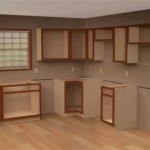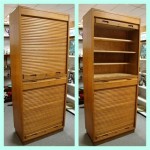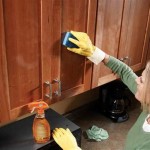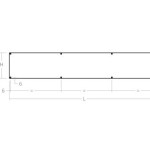Cream Gloss Kitchen Cupboard Paint: A Comprehensive Guide
The kitchen, often considered the heart of the home, frequently undergoes renovations to enhance both its aesthetic appeal and functional efficiency. Among the various elements contributing to the overall ambiance of a kitchen, the cabinetry holds a significant position. Choosing the right paint for kitchen cupboards is a crucial decision, impacting not only the look but also the durability and maintainability of the space. Cream gloss paint has emerged as a popular choice for kitchen cupboards, offering a blend of classic elegance and modern practicality.
This article delves into the intricacies of cream gloss kitchen cupboard paint, exploring its benefits, application techniques, selection criteria, and maintenance requirements. It aims to provide a comprehensive understanding of this popular paint option, enabling informed decisions regarding kitchen renovation projects.
The Allure of Cream Gloss: Aesthetic and Functional Advantages
Cream gloss paint offers a unique set of advantages that contribute to its popularity in kitchen design. These benefits stem from both its aesthetic qualities and its practical characteristics.
First, the color cream provides a versatile and neutral backdrop. It is inherently adaptable, harmonizing well with a wide range of color palettes, countertop materials, and backsplash designs. Unlike stark white, cream possesses a warmth and softness that creates a welcoming and comfortable atmosphere in the kitchen. This adaptability makes it easy to integrate cream gloss cabinets into existing kitchen styles or to use them as a foundation for a completely new design scheme.
Second, the gloss finish reflects light effectively. This reflective quality enhances the brightness of the kitchen, making it appear larger and more open. In kitchens with limited natural light, gloss paint can be particularly beneficial in maximizing the available illumination. Furthermore, the reflective surface allows the paint color to appear more vibrant and dynamic as light shifts throughout the day.
Third, gloss paint surfaces are relatively easy to clean. The smooth, non-porous surface of gloss paint resists stains and spills, making it simple to wipe away food splatters, grease, and other common kitchen messes. This ease of cleaning contributes to the long-term maintenance and hygiene of the kitchen.
Fourth, gloss paint provides a durable and protective coating. It is less susceptible to chipping and scratching compared to matte or satin finishes, especially when properly applied with a suitable primer. This durability ensures that the kitchen cupboards retain their appearance and structural integrity for an extended period.
Selecting the Right Cream Gloss Paint: Key Considerations
Choosing the appropriate cream gloss paint involves several key considerations, each contributing to the overall success of the painting project. Factors such as paint type, sheen level, application method, and environmental impact should be carefully evaluated.
One crucial consideration is the type of paint. Acrylic latex paints are generally recommended for kitchen cabinets due to their durability, ease of application, and low volatile organic compound (VOC) content. These paints offer excellent adhesion, resistance to moisture and mildew, and a wide range of color options. Oil-based paints, while offering exceptional hardness, are often less desirable due to their longer drying times, stronger odor, and higher VOC content. If oil-based paints are considered, proper ventilation and adherence to safety precautions are imperative.
Another important factor is the sheen level of the gloss paint. While a high-gloss finish offers maximum reflectivity and durability, it also tends to highlight imperfections on the cabinet surfaces. A semi-gloss finish provides a good balance between reflectivity, durability, and hideability. Experimenting with different sheen levels on a test surface is advisable to determine the most suitable option for the specific kitchen and cabinet conditions.
Furthermore, the application method influences the overall appearance and durability of the paint job. Spraying the paint, using either a conventional sprayer or an airless sprayer, typically results in the smoothest and most even finish. However, spraying requires proper preparation, masking, and ventilation. Brushing and rolling are also viable options, especially for smaller projects or for those without access to spraying equipment. When brushing or rolling, it is crucial to use high-quality brushes and rollers designed for gloss paints to minimize brushstrokes and roller stipple.
Finally, it is essential to consider the environmental impact of the paint. Choosing low-VOC or zero-VOC paints minimizes the release of harmful chemicals into the air, contributing to a healthier indoor environment. Water-based paints are generally more environmentally friendly than oil-based paints due to their lower VOC content and easier cleanup. Reading the paint label and selecting products that meet environmental standards are crucial steps in responsible paint selection.
Applying Cream Gloss Paint: Techniques and Best Practices
The successful application of cream gloss paint requires careful preparation, precise technique, and adherence to best practices. Rushing the process or neglecting essential steps can result in an unsatisfactory finish and reduced durability.
The first step is thorough preparation. Begin by removing all hardware, such as knobs, handles, and hinges, from the cabinet doors and drawers. Clean the surfaces thoroughly with a degreasing cleaner to remove any grease, dirt, or grime. Sand the surfaces lightly with fine-grit sandpaper to create a slightly roughened texture that will promote better paint adhesion. Fill any holes or imperfections with wood filler and sand smooth. Finally, wipe down the surfaces with a tack cloth to remove any remaining dust.
Next, apply a primer. Primer is essential for providing a uniform base for the paint, sealing the surface, and improving adhesion. Use a high-quality primer specifically designed for use with gloss paints. Apply the primer in thin, even coats, following the manufacturer's instructions. Allow the primer to dry completely before proceeding to the paint application.
Once the primer is dry, begin applying the cream gloss paint. Apply the paint in thin, even coats, using a brush, roller, or sprayer, as chosen. Avoid applying too much paint at once, as this can lead to drips and runs. Allow each coat to dry completely before applying the next. Sand lightly between coats with fine-grit sandpaper to remove any imperfections and create a smoother surface.
For a professional-looking finish, consider using a technique called "laying off" the paint. This involves lightly brushing or rolling over the wet paint in a single direction to eliminate brushstrokes or roller stipple. This technique requires practice and patience, but it can significantly improve the appearance of the finished product.
Finally, allow the paint to cure completely before reattaching the hardware and putting the cabinets back into use. Curing is the process by which the paint hardens and reaches its maximum durability. The curing time varies depending on the type of paint and the environmental conditions, but it typically takes several days or even weeks.
Throughout the entire process, maintaining a clean and well-ventilated workspace is crucial. Protect surrounding surfaces with drop cloths and painter's tape. Wear appropriate safety gear, such as gloves and a respirator, to protect against exposure to paint fumes and dust.
Proper surface preparation is paramount to achieving a flawless cream gloss finish on kitchen cupboards. Failing to properly clean, sand, and prime the surfaces can result in poor adhesion, uneven coverage, and a less durable paint job. This ultimately leads to a less aesthetically pleasing and potentially shorter-lived result.
Furthermore, the quality of the tools used to apply the paint plays a significant role in the outcome. Investing in high-quality brushes, rollers, or sprayers designed for gloss paints can make a noticeable difference in the smoothness and evenness of the finish. These tools are designed to minimize brushstrokes, roller stipple, and overspray, contributing to a more professional-looking result. Skimping on tools can lead to frustration and a less satisfactory outcome.
Careful attention to detail is essential throughout the painting process. This includes masking off surrounding surfaces, sanding between coats, and cleaning up spills and drips promptly. Neglecting these details can result in a messy and unprofessional-looking finish. A meticulous approach, combined with patience and practice, is the key to achieving a beautiful and durable cream gloss finish on kitchen cupboards.

Rust Oleum Clotted Cream Gloss Kitchen Cupboard Paint 750ml Diy At B Q

Behr Premium 1 Gal Ppu5 10 Heavy Cream Satin Enamel Interior Exterior Cabinet Door Trim Paint 752001 The Home Depot

Modern Kitchen Decor Interior

Rust Oleum Clotted Cream Gloss Kitchen Cupboard Paint 750ml Diy At B Q

36 Cream Gloss Kitchens Ideas Kitchen Design

Venice True Handleless Kitchen In High Gloss Cream

Rust Oleum Clotted Cream Matt Kitchen Cupboard Paint 750ml Diy At B Q

Sofia Cream Gloss Kitchen Green Walls Colors

Kitchen Cupboard Paint How To Your Cupboards

7 Colors That Enhance Cream Kitchen Cabinets
Related Posts








